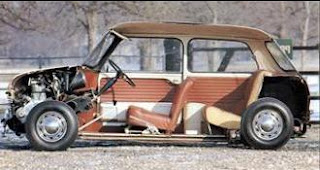
Born of necessity during the Suez Crisis, it had a revolutionary design for the time - with front wheel drive, the gears mounted in the engine's sump and a transverse engine. The entire engine and transmission unit was contained on sub frames and fitted compactly under the Mini's tiny bonnet.
It was also VERY small - just over 10 feet long - which made it all the more incredible that it could take 4 people and (some) of their luggage.It has been available as saloon, station wagon, pick-up, van, cabriolet, utility vehicle (Moke) and numerous other permutations!

The suspension system, designed by Issigonis' friend Dr. Alex Moulton at Moulton Developments Limited, used compact rubber cones instead of conventional springs. This ingenious space-saving design also featured rising progressive rate springing of the cones, and provided some natural damping force. Built into the sub frames, the rubber cone system gave a raw and bumpy ride which was accentuated by the woven-webbing seats, but the rigidity of the rubber cones, together with the wheels being pushed out to the corners of the car, gave the Mini go kart-like handling that would become famous.
Initially an interconnected fluid system was planned — similar to the one which Alec Issigonis and Alex Moulton were working on in the mid-1950s at Alvis. They had assessed the mechanically interconnected Citroen 2CV suspension at that time (according to an interview by Moulton with CAR magazine in the late 1990s), which inspired the design of the Hydrolastic suspension system for the Mini and Austin 1100, to try to keep the benefits of the 2CV system (ride comfort, body levelling, keeping the road wheel under good control and the tyre in contact with the road), but with added roll stiffness that the 2CV was very much lacking.
Click here to read Revolutionary Design of Mini Car (Part II)
No comments:
Post a Comment